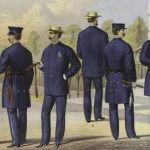How Police Departments Had Their Beginning

Early American police departments were under the control of local politicians. The local political leaders, who were mostly the owners of neighborhood taverns or purveyors of gambling and prostitution, were the ones who appoint the police executive in charge of their local neighborhood. With the police being on these scrupulous merchants and political leaders’ payrolls, it’s no wonder that there was massive distrust with the police force.
With these known and rampant corruption and police brutality, in 1929, President Hoover appointed the Wickersham Commission to examine the perceived ineffectiveness of the police department to reduce crime rate. Despite the commission’s findings published in 1931 and 1932 that shocked the nation – with its report on police brutality, corruption, wiretapping, bribery, coercion of witnesses, and fabrication of evidence – the police department continued as a bureaucratic entity defiant to both outside influence and reform.
There were other attempts to reform the police department, oftentimes from the police commissioners and chiefs as well who were appointed as a replacement from the previous one terminated due to scandals. The goal of these reforms was to loosen the grip of politicians and corporations on the department.
By the 1960s, due to massive social and political changes happening in the country, they were many mass uproars on police brutality and oppression. It was now hard to ignore scandals created on how police handled large demonstrations and used its force to suppress the Civil rights movement.
In an attempt to improve the police image, the drive to professionalize the police and criminal justice system followed. In the 1970s and early 1980s, the police came again to a massive reorganization dubbed as “Taylorization of the police force”. Police departments reduced the number of their personnel. They also increased the division of labor within departments. Another change was breaking down the police tasks into more specific and specialized tasks. The “taylorization” aims to isolate the police from the neighborhood they were located and the social work aspect of policing discouraged. Instead of being too involved with the neighborhood, they wanted the police force to be efficient and focused on crime-fighting and crime-solving.
In the late 1980s, many police departments across the nation had started a new strategy to improve police image. Their strategy? Community policing. If earlier they were discouraging community involvement, with the new program, the police department wanted to have close relations with them. They aim to alleviate a wide variety of community problems, many of which were social in nature. The community policing program is an effort to decentralize the police, improve relations with the community, and to make citizens more comfortable with police presence.
Currently, there are 17,985 U.S. police agencies in the U.S. They include the City Police Departments, State Police or Highway Patrol, County Sheriff’s Offices, and Federal Law Enforcement Agencies. City Police also known as Municipal police can be a one-person agency (sometimes called town marshal) to a huge one like the New York Police department which employs 40,000 police officers. State Police or Highway Patrol provides statewide law enforcement duties such as investigations and state patrols. County Police have countywide jurisdiction and in case the place has both county police and county sheriff, county police duties are to patrol and investigate whereas county sheriff can serve papers and provide security to the courts. Federal Law Enforcement Agencies’ typical responsibilities include immigration and border management, countering fraud against the federation, national security, giving protection to the country’s head of state, or other designated important persons.
Post written by Lawrence Harrick. Lawrence can also be found writing for Credit Glory.



 D5 Creation
D5 Creation
Comments are Closed